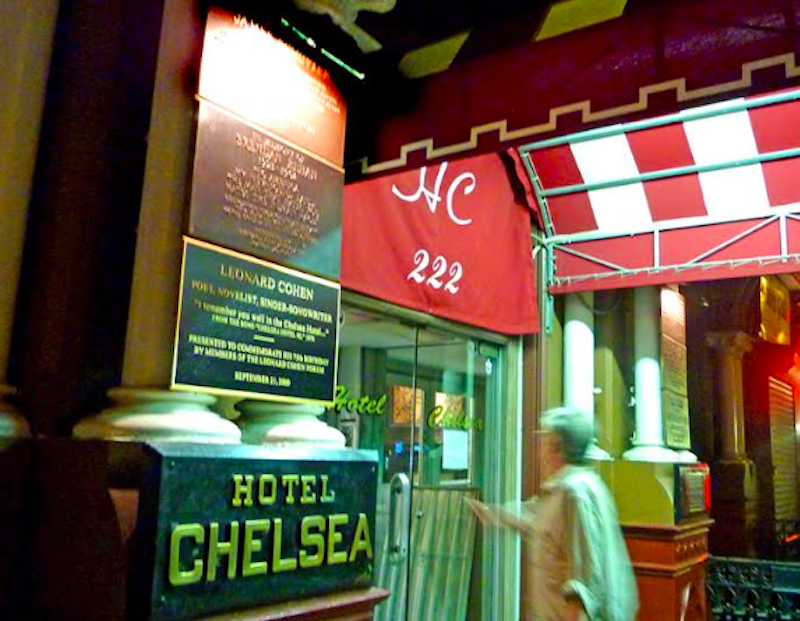The Hotel Chelsea was about to change. The hotel was preparing for a decades-long battle over a bought-and-sold restoration. Tonight, during the late-1990s, we have a seasonal Christmas Eve mix with three holiday orphans pondering the future standing in front of 222 W. 23rd St., a New York City hotel’s famous entrance wondering what’s to come. The bright neon hotel sign shines light over an entire city block.
Whenever I passed by the Hotel Chelsea, I’d often reflect on how legends are born and how times have changed. This was a chance to say a little Saint Andy prayer, think about exploring the gardens on the roof, recall the time I saw and heard Chelsea Girls or discovered a burned teaspoon in a hotel kitchen cabinet. The hotel had a significant impact on the lives of numerous artists.
There were others who felt the same way. A recent documentary Dreaming Walls by Maya Duverdier and Amelie van Elmbt was shot in the Hotel Chelsea during this transition period. The hotel’s defined in a novel way, helping shed light on the bohemian artistic way of life and the myth-making process. In the film, composer Virgil Thomson, a longtime Chelsea resident, put it this way when asked, “How do you like the idea of living in a hotel?” He said, “Since when is living in a hotel an idea.”
Herbert Huncke, who coined the term “Beat” would sit in the lobby. The pale, guilty-of-everything hustler was hardly visible reclining in a comfortable chair underneath a large, white horse painting. Behind the wall, artist Richard Bernstein, diligently working on one of his 189 Andy Warhol Interview covers inside his studio, wasn’t visible. Manager Stanley Bard was rushing around behind the front counter going over paperwork. Gift-wrapping the lobby, the watch guards were a large Dutch Masters cigar box oil and wood collage by Larry Rivers and a black and white Donald Baechler painting of a vase of flowers.
The orphans on W. 23rd St. were enjoying the unusually warm December weather that evening. Their conversation rambled around many topics. Then I realized this the same street where Clement Clarke Moore once resided. Moore, who administered Alexander Hamilton his last rites after an infamous duel, wrote a famous poem for his own children in 1822 called “Twas Night Before Christmas.”
The poem helped establish the concept of contemporary Christmas. It first appeared on December 23rd, 1823, in the Troy Sentinel, a newspaper published in upstate New York. The Moore family estate once stood in the center of Chelsea. Rumor has it Moore was particularly motivated after seeing a robust rapscallion while out on a sleigh ride, off to purchase a turkey at the market on a winter shopping day. A commemorative cornerstone can be found beside a London Terrace entranceway on the bottom left side of the building, in the middle of the 400th block of W. 23rd St. between 9th and 10th Aves.
“Twas the night before Christmas, when all thro’ the house,
not a creature was stirring, not even a mouse.
The stockings were hung by the chimney with care,
In hopes that St. Nicholas soon would be there.”
Now was time for some holiday cheer. The orphan trio quickly noticed a theme restaurant just east of the hotel at 206 W. 23rd St. Always up for some next level entertainment or great suspense, we went in to check out La Nouvelle Justine. The establishment claimed it was first ever S&M cafe; the place wasn’t open very long. Joan Rivers went there once, which made it sound like it was something extraordinary. Well, it was anything but.
One gimmick was serving food in dog bowls presented by busboy slaves. There was also an ongoing neighborhood controversy over some raunchy, Victorian-style underwear signage facing the street. Worried local parents made it a minor media case, as afternoon grade-schoolers on their way home laughed while passing by. Considering the block’s history, that seems sort of lame.
Inside that evening, the dark bar was empty. The show began when someone stumbled and fell on the floor leaving the restroom. The hidden identity of the creative force behind this appearance remains a mystery; a disheveled drag queen with drippy make-up, teetering in heels, had a hard time readjusting a wig. The room was filled with adult high-chairs for dishes like: pudding served in a nine-inch stiletto.
We hadn’t even been there a minute when a young man came barreling over out of nowhere. The guy knelt and wanted to see the high heels and red nail polish on my friend’s feet. Would she like a foot massage, he enquired. In shock, everyone turned to face one another. Without any constraints, (no pun intended) the activity came across as buzzkill. Staying around seemed to decry New York’s fetish community. So, we left. Guess we’ll never know if the drag queen ever got the wig back on.
In the forgotten era of 1960, Arthur Miller wrote a brilliant essay in a sixth-floor room with a view of a parking lot. The Hotel Chelsea was less known then. Considering the restoration dust has settled; the squeaky clean, retro-renovated luxury hotel results are clear: something’s missing. The creative souls and colorful population of yesterday is gone. The Hotel Chelsea is no longer what it once was as it continues to navigate its course through history.
“Happy Christmas to all, and to all a good night!”

